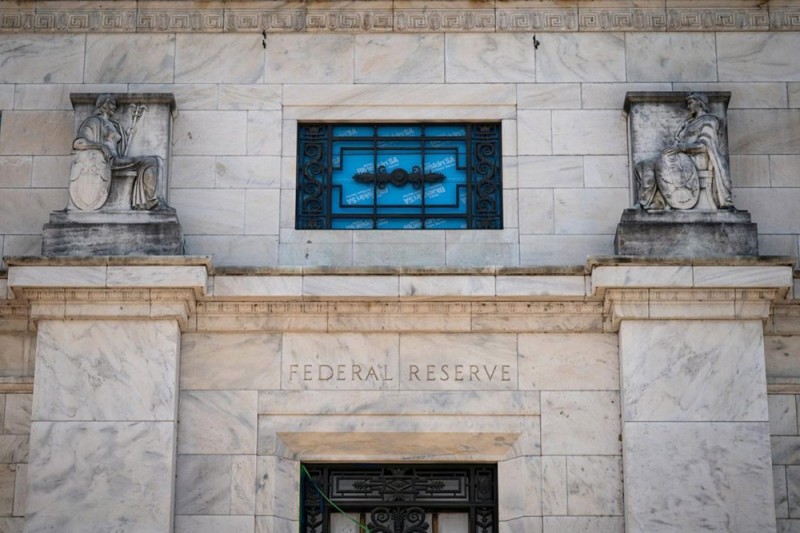
• 牛津经济研究院(Oxford Economics)指出,美联储(Federal Reserve)在今年12月降息50个基点的可能性正在上升。尽管6月的就业报告显示整体数据表现强劲,但其深层数据却表明劳动力市场正在走弱。如果就业市场意外崩盘,美联储将被迫大幅降息。
降息将成为观察经济前景的“晴雨表”。
在前景不明的背景下,利率变动将揭示经济前景光明,还是陷入衰退。
一方面,降息可能意味着美联储终于认为通胀威胁已消退,并且在关税带来的不确定性消除之后,经济预期重新趋于稳定。这是投资者和总统唐纳德·特朗普最乐见的结果。但在相关不确定性消除之前,利率将维持当前水平。
然而,还有另外一种情景:降息并非备受期待的解脱信号,而是令人担忧已久的经济下行的开端。如果劳动力市场的状况突然恶化,美联储将不得不出手降息。在这种情况下,投资者和总统将得到超出他们预期的结果:降息50个基点。
如此大幅度的降息,相当于通常25个基点的两倍,只有在失业率飙升、企业在今年晚些时候停止招聘的情况下才会发生。美联储此前之所以按兵不动,主要是担心特朗普的关税政策重新引发通胀。但近几周,美联储 “双重使命”中的另一项使命失业问题,已成为关注焦点。投资者同样担心,就业市场或已处于摇摇欲坠的边缘。
牛津经济研究院美国首席经济学家南希·范登·霍滕表示:“我们认为,首次降息幅度达到50个基点的风险正在上升。”
牛津经济研究院仍预测美联储将在12月进行一次25个基点的降息。但该机构开始考虑大幅降息的可能性,这显示出它确实担心劳动力市场可能会迅速甚至剧烈恶化。劳动力市场衰退的性质比其他任何因素都更重要。
盈透证券(Interactive Brokers)高级经济学家何塞·托雷斯表示:“如果发生突发性的意外冲击,将促使美联储年底进行一次50个基点的降息。情况在年底时快速恶化,才会发生这种情况。”
如果坏消息势头迅猛且严重,美联储将不得不仓促应对。
范登·霍滕对《财富》杂志表示:“我们确实看到,美联储首次降息幅度扩大的风险正在上升,即降息幅度达到50个基点,因为我们认为届时美联储可能需要应对劳动力市场的变化。”
尽管4月关税政策公布后市场动荡不安,但当前劳动力市场仍相当稳定。然而,在表象之下已出现了一些微妙变化,显示市场正逐步走向宽松。根据美国劳工统计局(Bureau of Labor Statistics)的数据,6月失业率从4.2%小幅下降至4.1%,同时新增就业岗位为14.7万个。这一亮眼数据掩盖了就业市场增长势头放缓的事实。私营部门就业增长创8个月以来新低;13万人退出劳动力市场;失业者的待业时间延长。
这些细微变化虽不表明劳动力市场危在旦夕,但这种变化正在影响着经济的运行态势。
范登·霍滕表示:“这些数据并非糟糕透顶,这使得美联储目前可以更专注于通胀问题。最新的数据让美联储稍感宽慰,不过6月的就业数据中确实存在一些特殊因素,可能使劳动力市场看上去比实际情况略好一些。”
托雷斯指出,经济增速必须大幅低于预期,且10月和11月的月度新增就业岗位低于5万个,整体经济形势才会迅速恶化,从而迫使美联储进行一次50个基点的降息。
目前来看,发生这两种情况的可能性不大。投资者预计,年内经济增长和劳动力市场将有所放缓,但尚不至于跌至上述水平。华尔街多家机构和经济学家已下调年末经济增长预期,同时上调了通胀预期,主要原因在于关税的影响。随着特朗普新的关税最后期限临近,一些机构再次下调了增长预期。
尽管如此,在特朗普再度掀起关税风波之际,市场仍保持稳定。市场似乎已经基本消化了华尔街下调2025年剩余时间增长预期的影响。事实上,本周早些时候,特朗普宣布对多个国家实施一系列新的、可能具有决定性意义的关税措施后,市场基本未受到影响。在此之前,标普500指数刚刚在7月初创下历史新高。 (*)
译者:刘进龙
审校:汪皓
• 牛津经济研究院(Oxford Economics)指出,美联储(Federal Reserve)在今年12月降息50个基点的可能性正在上升。尽管6月的就业报告显示整体数据表现强劲,但其深层数据却表明劳动力市场正在走弱。如果就业市场意外崩盘,美联储将被迫大幅降息。
降息将成为观察经济前景的“晴雨表”。
在前景不明的背景下,利率变动将揭示经济前景光明,还是陷入衰退。
一方面,降息可能意味着美联储终于认为通胀威胁已消退,并且在关税带来的不确定性消除之后,经济预期重新趋于稳定。这是投资者和总统唐纳德·特朗普最乐见的结果。但在相关不确定性消除之前,利率将维持当前水平。
然而,还有另外一种情景:降息并非备受期待的解脱信号,而是令人担忧已久的经济下行的开端。如果劳动力市场的状况突然恶化,美联储将不得不出手降息。在这种情况下,投资者和总统将得到超出他们预期的结果:降息50个基点。
如此大幅度的降息,相当于通常25个基点的两倍,只有在失业率飙升、企业在今年晚些时候停止招聘的情况下才会发生。美联储此前之所以按兵不动,主要是担心特朗普的关税政策重新引发通胀。但近几周,美联储 “双重使命”中的另一项使命失业问题,已成为关注焦点。投资者同样担心,就业市场或已处于摇摇欲坠的边缘。
牛津经济研究院美国首席经济学家南希·范登·霍滕表示:“我们认为,首次降息幅度达到50个基点的风险正在上升。”
牛津经济研究院仍预测美联储将在12月进行一次25个基点的降息。但该机构开始考虑大幅降息的可能性,这显示出它确实担心劳动力市场可能会迅速甚至剧烈恶化。劳动力市场衰退的性质比其他任何因素都更重要。
盈透证券(Interactive Brokers)高级经济学家何塞·托雷斯表示:“如果发生突发性的意外冲击,将促使美联储年底进行一次50个基点的降息。情况在年底时快速恶化,才会发生这种情况。”
如果坏消息势头迅猛且严重,美联储将不得不仓促应对。
范登·霍滕对《财富》杂志表示:“我们确实看到,美联储首次降息幅度扩大的风险正在上升,即降息幅度达到50个基点,因为我们认为届时美联储可能需要应对劳动力市场的变化。”
尽管4月关税政策公布后市场动荡不安,但当前劳动力市场仍相当稳定。然而,在表象之下已出现了一些微妙变化,显示市场正逐步走向宽松。根据美国劳工统计局(Bureau of Labor Statistics)的数据,6月失业率从4.2%小幅下降至4.1%,同时新增就业岗位为14.7万个。这一亮眼数据掩盖了就业市场增长势头放缓的事实。私营部门就业增长创8个月以来新低;13万人退出劳动力市场;失业者的待业时间延长。
这些细微变化虽不表明劳动力市场危在旦夕,但这种变化正在影响着经济的运行态势。
范登·霍滕表示:“这些数据并非糟糕透顶,这使得美联储目前可以更专注于通胀问题。最新的数据让美联储稍感宽慰,不过6月的就业数据中确实存在一些特殊因素,可能使劳动力市场看上去比实际情况略好一些。”
托雷斯指出,经济增速必须大幅低于预期,且10月和11月的月度新增就业岗位低于5万个,整体经济形势才会迅速恶化,从而迫使美联储进行一次50个基点的降息。
目前来看,发生这两种情况的可能性不大。投资者预计,年内经济增长和劳动力市场将有所放缓,但尚不至于跌至上述水平。华尔街多家机构和经济学家已下调年末经济增长预期,同时上调了通胀预期,主要原因在于关税的影响。随着特朗普新的关税最后期限临近,一些机构再次下调了增长预期。
尽管如此,在特朗普再度掀起关税风波之际,市场仍保持稳定。市场似乎已经基本消化了华尔街下调2025年剩余时间增长预期的影响。事实上,本周早些时候,特朗普宣布对多个国家实施一系列新的、可能具有决定性意义的关税措施后,市场基本未受到影响。在此之前,标普500指数刚刚在7月初创下历史新高。 (*)
译者:刘进龙
审校:汪皓
• The chances the Federal Reserve will cut interest rates by 50 basis points in December are growing, according to Oxford Economics. The June jobs report showed strong headline numbers, but the underlying data pointed to a weakening labor market. If it cratered unexpectedly the Fed would be forced into such a large rate cut.
Interest rate cuts will be a crystal ball.
Amid a cloudy outlook, they’ll reveal either good economic fortune or a downturn.
On the one hand, interest rate cuts could mean the Federal Reserve has finally deemed the threat of inflation has passed and economic forecasts stable again after the tariff-induced uncertainty. That is the outcome investors and President Donald Trump would most welcome. But until any of that uncertainty subsides, interest rates will remain where they are.
There is, however, one scenario, in which rate cuts aren’t a sign of eagerly awaited relief but of the start of a long-feared downturn. In the event the labor market suddenly starts to go south, the Fed would have to step in and cut rates. In that case, investors and the president would get more than they bargained for: an interest rate cut of 50 basis points.
A rate cut of that size, double the usual 25 basis points, would only come if unemployment spiked and companies stopped hiring later in the year. The Fed started its holding pattern, largely worried Trump’s tariffs would reignite inflation. But in recent weeks, there has been a greater focus on unemployment—the other side of its dual mandate. Investors, too, are worried the labor market may be teetering.
“We think the risk is growing that the first cut is 50 basis points,” said Nancy Vanden Houten, lead U.S. economist at Oxford Economics.
Oxford Economics still forecasts a single rate cut of 25 basis points in December. But the fact the firm is entertaining a jumbo rate cut points to genuine fears the bottom may fallout from the labor market quickly, even dramatically. It’s the nature of the labor market slump that matters more than anything else.
If it is “unexpected in a shock kind of way, that would motivate a 50-basis-point reduction at the end of the year,” said Jose Torres, senior economist at Interactive Brokers. “You would need things to go bad really quickly towards the end of the year for that to happen.”
If the bad news is swift and severe, then the Fed will have to scramble.
“We do see a growing risk that the first move is larger, i.e. 50 basis points, because we think the Fed at that point may have some catching up to do” with the labor market, Vanden Houten told Fortune.
The current labor market is remarkably stable despite the market turbulence that surrounded the original tariff announcements in April. Under the surface, though, there are some subtle changes indicating it is loosening. In June, the unemployment rate actually ticked down to 4.1% from 4.2%, according to data from the Bureau of Labor Statistics. That headline number—which came alongside 147,000 new jobs—belied slowing momentum in the job market. Private sector jobs grew at the lowest level in eight months; 130,000 people dropped out of the labor force; and individuals out of a job were staying unemployed for longer.
Those nuances don’t point to a labor market in imminent danger, but one that is shifting beneath the economy’s feet.
“The numbers aren’t horrible, allowing the Fed to focus more on inflation right now,” Vanden Houten said. “The latest data allow the Fed to breathe a little easier, although there were definitely some quirks in the June employment data that probably made the labor market look a little better than it is.”
Economic growth would have to significantly underperform expectations and hiring levels would need to be below 50,000 a month in October and November for the economic picture to worsen quickly enough to force a 50 basis point cut, according to Torres.
The possibilities of both happening are unlikely at the moment. Investors expect growth and the labor market to slow later in the year, but not to those levels. Wall Street firms and economists lowered their forecasts for year-end growth and raised those for inflation, mainly citing tariffs. Some have revisited those projections, lowering them further, as Trump’s looming tariff deadline looms.
That said, markets have remained steady amid a renewal of Trump’s tariff whirlwinds. Markets seem to have largely already priced Wall Street’s lower forecasts for the rest of 2025. In fact, markets were largely unmoved earlier this week as Trump announced a series of new and possibly definitive tariffs on a host of countries—all of which came after the S&P 500 hit a new all-time high at the start of July.

